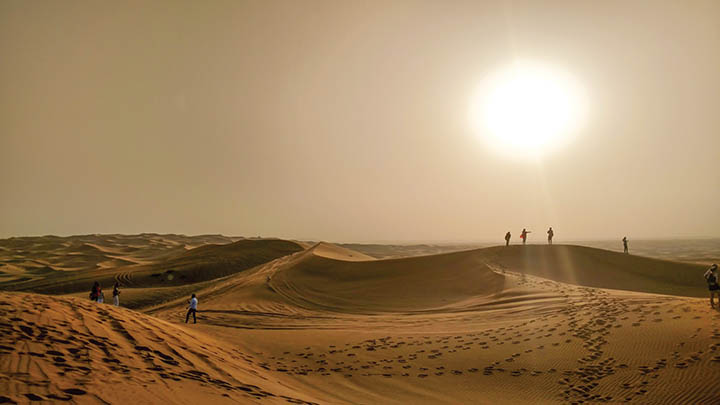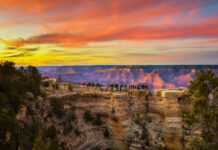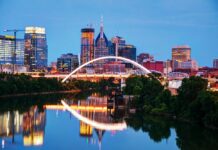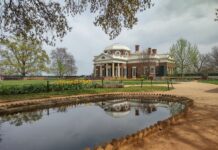As my wife Nataliya and I flew into Dubai, and later when we looked from the observation decks of the Burj Khalifa and Burj Al Arab, it was easy to see we were in the middle of a desert — sand as far as the eye could see in all directions but one, where the blue of the Persian Gulf (or Arabian Gulf, as they call it) shimmered.
But from the bottom looking up, as we passed majestic skyscrapers, strolled in flower gardens and admired the green parks and medians, it was easy to forget we were in a desert.
That’s the result of the Emiratis striving to go big and best: World’s tallest building, one of its fastest elevators, highest indoor ski slope, largest mall, highest restaurant, highest dwelling, highest observation deck, longest automated metro line … the list is as big as the city.
Yet they’ve managed to preserve (in some cases recreate) Emirati heritage and architecture — especially along Dubai Creek, in the Al Fahidi area and at the heritage centers and museums.
Perhaps these record-breaking developments, amidst remains of the old, are all part of Dubai’s plan to become the biggest and best tourist destination.
Sky High
Our old college friend, Sadiq, and our new friend, Najeeb, were gracious enough to act as our tour guide. First, they took us to the places that most tourists want to see first: Dubai Mall and the Mall of the Emirates. The malls in UAE are like palaces, decked out with fountains, statuary and art. You can even hit the slopes in the mall, where there’s snow every day. But we were interested in the skyscrapers outside.
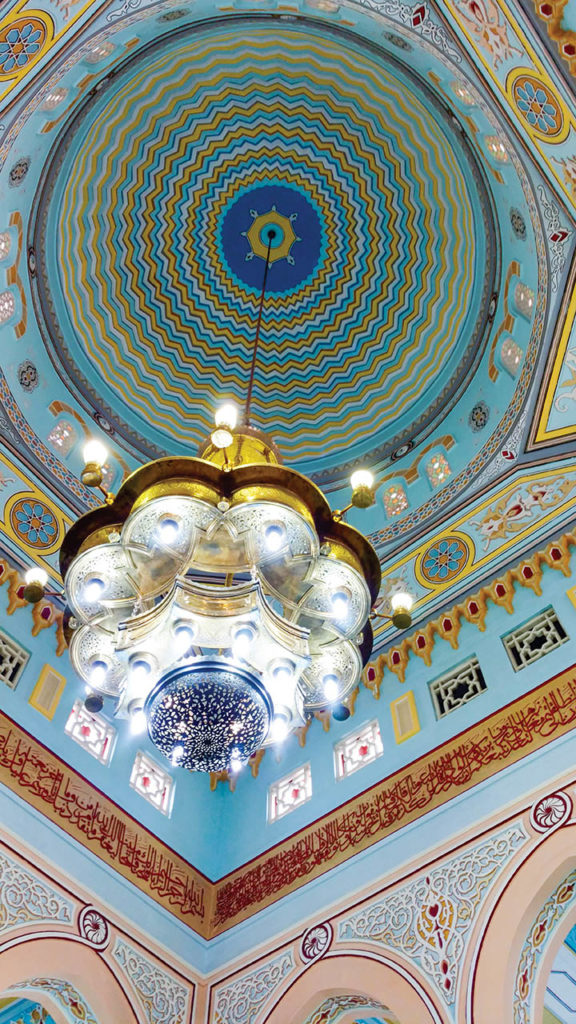
Everything from the stately to the whimsical is represented in the local architecture. Some of the most interesting skyscrapers can be seen along Sheik Zayed Road in the financial district: The Dubai International Financial Centre looks like a giant cube of stone and glass, and Dubai’s World Trade Centre was one of the first skyscrapers built in the city, back in 1979. Some towers have modern flair, others are more classic.
Towering over everything: The Burj Khalifa, the world’s tallest building is so high that you can watch the sun set twice in one visit.
Another icon is the Burj Al Arab, situated on its own manmade island off the Arabian coastline. From Jumeirah Beach, one of the world’s most well-known and opulant hotels appears to puff out with its “sail” along the horizon.
The audacious feats of architecture don’t end with towers. There are the manmade Palm Islands, shaped like giant trees in the gulf. Each palm is a gated row of multi-million dollar mansions. With another project, Dubai conquered the world: “The World” is a collection of 300 manmade islands that form a map of Earth.
An aside: All of those scenes in movies, on television and in photographs depicting the Middle-Eastern sun beneath a sandy haze, glowing orange, are not simply the visions of an artist. This is really what the sun looks like here — you can look directly into it — and it’s beautiful.
Back to the Old
A walk to Dubai Creek on a cool, 99-degree morning gave us an opportunity to see Dubai’s nitty-gritty daily life up close, passing apartment buildings, offices, storefronts and mosques.
Dubai Creek is the place to see Dubai of yesteryear. Less than a century ago, this was the heart of Dubai, consisting of stone, gypsum, wood and palm frond courtyard houses. In the Al Fahidi neighborhood, an old fort from the late 1700s is home to Dubai Museum. Throughout the area, old buildings have been restored and new ones recreated in the traditional style.
At the creek, we took an abra, or traditional water taxi, across to the market area. The wooden abras still ferry as many locals as tourists for about 30 cents a ride. The five-minute cruise along the creek offered a pleasant view of the sand-plaster waterfront.
On the other side of Dubai Creek awaited the souqs. These markets have modern conveniences, but looked like scenes from a century ago. People from around the world buy gold, spices and textiles in these dusty streets.
On another morning drive, mosques dotted the street corners like Starbucks in America.
“Why are they all slanted?” Nataliya asked.
“They’re positioned to face Mecca,” Sadiq explained.
There was much to learn, and we started with the Jumeirah Mosque’s “Open Doors, Open Minds” tour, which introduces visitors to Islam and Emirati culture. Our tour started with a reception: Arabic coffee, tea, fried bread, figs and dates. In the courtyard, we washed our feet, hands and faces at a stone fountain before entering the mosque.
The interior glowed with pastel colors. A green Persian rug with orange lines filled the floor. Those lines indicated where to line up for prayer. Arabic calligraphy and etched designs decorated the walls, trimmed the frames and filled out the inside of the dome. The windows were bejeweled with stones, allowing the sunlight to penetrate. It was a beautiful place to explore and to start an understanding of local customs, culture and religion.
Somewhere in the Middle of Nowhere
The middle of nowhere may not sound exciting — but the most popular excursion in UAE is a desert safari.
A 4×4 Jeep picked us up in the afternoon. We were accompanied by our host, Khalid, and two couples: one from Sochi, Russia, and one from Singapore.
Khalid stopped the Jeep where the road ended, the brown-red ripples of wind-kissed desert stretched out before us.
He let air out of the tires, switching from asphalt to sand mode. Squeals of exhilaration erupted inside the Jeep as Khalid zoomed up and down the sand dunes, sliding down sideways, launching the tires into the air before plunging back into a dune with a sandy splash. As we “dune bashed,” we were joined by other 4x4s, the drivers competing, taking turns plunging into an enormous sand pit and then up again.
“Safety in numbers,” the Singaporean man said. “If one of us has auto trouble, others can help.”
At camp, we were greeted with dates, Arabic coffee and tea. A man chopped the tops off of coconuts with a machete and offered them for us to drink.
In the orange glow of afternoon, Nataliya and I mounted our camel and went for a sunset ride. Occasionally, a falcon looped overhead, then returned to its master at camp. The sun went orange to amber to gone.
Back at camp, we enjoyed the festivities: A fire-dancer juggling and swallowing flame; a woman belly dancing; a colorfully dressed man holding decorative drums and performing a Tanoura dance, spinning around so fast and long that we were shocked to see him walk in a straight line after.
Seated around the stage on pillows and low tables, we indulged in a large meal of traditional foods, including dishes of beef, goat, chicken, rice, couscous, beans, chickpeas and lentils. After dinner, we tried shisha or hookah.
My Dubai
“This is my Dubai,” Khalid said as we drove from the desert, Dubai’s city lights glowing ahead of us.
“There’s something to be said for the history,” the man from Sochi said. “My city was completely changed thanks to Olympics. Many can’t afford to live in their homes anymore.”
“It’s progress,” Khalid argued agreeably. “We must look to our future.”
“There’s the future,” I said, pointing to the bright lights of the big city. “Like Vegas on steroids.”
The man from Sochi chuckled. “We also learned from Olympics, steroids get you in trouble.”
Nataliya said, “It’s like the gentrification of a neighborhood. Some love it, because development’s good for property values. Some hate it, because it pushes out natives and draws a new population, those who can afford it.”
Khalid shook his head. “It’s different here.” We were now within the city, bright lights towering all around us. “Here, the wealthy are the natives. Given a choice between camels and palm huts or Maserati and towers of glass and gold, anyone will take the latter.”
I nodded. “History and culture are interesting when you’re visiting. But when it comes to daily life, who doesn’t want comfort and convenience?”
Khalid smiled, looking ahead. “This is my Dubai. My future.”
Where to Stay
We stayed at the City Seasons Towers Hotel, which was conveniently located in Bur Dubai — a 45-minute walk to Dubai Creek and 15-minute metro ride to Burj Khalifa. We managed to find a good rate online at just above $100 a night for a decent-sized, clean, comfortable room — with breakfast included. There’s also the Burj Al Arab, with suites going from $2,000 to $27,000 a night, and plenty of choices in between.
Where to Eat
The Burj Al Arab may be a contender for world’s highest-priced hotel, but eating there is a reality for most visitors and is worth the splurge. Afternoon tea can cost about $150 per person. If your goal is to see the extravagance of the lobby and some of the public areas of the building, opt for a full dinner in Burj Al Arab’s lower-level restaurant, Junsui, with the best Asian food in Dubai, for roughly the same price.
What to Do
Don’t miss the observation tower of Burj Khalifa, which offers better exterior views than the Burj Al Arab. The “Open Doors, Open Minds” tour at Jumeirah Mosque is enlightening and enchanting. A desert safari is good fun. It’s best to book tickets in advance, which you can do at vacation sites like TripAdvisor or Viator.
Further Afield
If you’re in UAE for more than a few days, a day or two in Abu Dhabi is a must. There, visit the luxurious Sheikh Zayed Grand Mosque and Emirates Palace Hotel. They alone make it well worth the trip.


